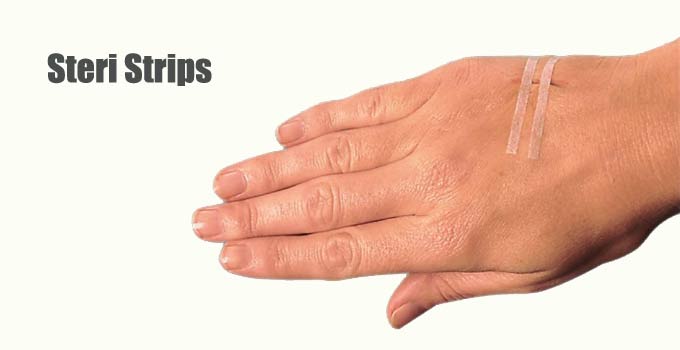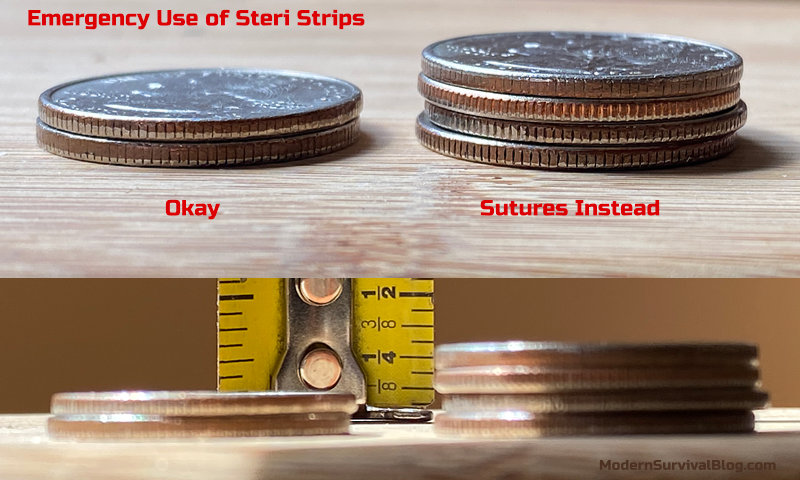Steri Strips | Instructions How To Apply & Use

Wound Care & Guidelines when and how to apply and use Steri Strips for wound closure or when to Suture instead.
UPDATED TIP below… “When” to use steri strips for emergency versus when sutures would be better.
Will I be able to actually sew myself back up if something happens that requires it?
I’ve got the suture kits, steri strips, everything to clean the wounds or whatever, but, can I pull off stitching myself up?
That question from a reader here on MSB inspired another reader (with medical credentials) to answer with some great insight and guidelines. I’ve detailed it as follows:
Steri Strips & Butterfly Stitches
On the strips, there are two kinds. Steri strips and Butterflys.
Steri strips come in 1/8″, 1/4″ & 1/2″ size widths.
1/8″ x 3″ 3M Steri-Strip Skin Closures
(view on amzn)
1/4″ x 3″ 3M Steri-Strip Skin Closures
(view on amzn)
1/2″ x 4″ 3M Steri-Strip Skin Closures
(view on amzn)
‘Butterflys’ are available in large and small.
When to Use Steri Strips
Depth of the Wound
The depth of the wound is what matters with steri strips.
– Less than 3/16″ deep, likely okay to use tape (strips).
– Deeper than 1/4″, probably should be sutures.
– In between, at 3/16″, it’s “iffy”, tape or suture.
UPDATE:
Tip: The thickness of two ‘quarters’ is slightly less than 3/16″. It’s actually in-between two and three ‘quarters’. So you might say a wound depth more than that will be better treated with sutures.

How to Apply Steri Strips to close a wound
Tincture of Benzoin
Before applying strips, consider using tincture of benzoin on the skin next to but not into the wound. It’s an antiseptic preparation used on the skin, since it dries to a tacky consistency to enhance the adhesion of band-aids. Tip: Apply it with a Q-tip: Tincture Of Benzoin, 4 FL.OZ.
Apply Strip | One Side, Pull to Other Side
Apply the steri strip on one side of the wound — and then pull to the other side to close the wound. Start at one end of the wound and work towards the other with more steri strips as necessary.
Minimize Infection
Close the wound as soon as you can. This will minimize infection.
The rule in the ERs that I worked in was get to us within 6 to 12 hours. We might consider closing one that had been left open longer but probably not.
The longer the wound is left open the greater the chance of it becoming infected.
Deep Wounds require special care
Close the wounds in layers. If you pull the edges together over a deep wound you might get an abscess under it. I’m not going to describe suture technique as I’m sure there must be thousands of online videos.
Lidocaine & Xylocaine
They are essentially the same and come in 2 strengths.
They may or may not have epinephrine in them.
Epinephrine will reduce the wounds bleeding by constricting the veins and arteries around it. It will provide some numbness. The body will reabsorb the medication. The epinephrine will slow circulation in that location.
Fingers, Toes and Nose are never injected with Lidocaine with Epi. Damage to tissue from lack of circulation in those places could lead to amputation.
Wound Healing by Granulation
If a wound can’t be sutured it heals by granulation. It will slowly fill in from the bottom up.
At least daily dressing changes will need to be done and the wound cleansed & observed for signs of infection.
Not all wounds need to be closed with Lidocaine. First, lidocaine burns like crap when you’re injecting it and you have to inject it numerous times around the edge of the wound, When I was in Vietnam and going to sew some dude up I’d give them a choice. Most would not opt for the stuff that stings.
I had an incident where I was building a shed and walked into a corner of the metal roof. I needed stitches and at the time I was without insurance. The equipment was available. I sewed myself shut in the bathroom mirror. It was kind of difficult as all the moves were backwards in the mirror. No lidocaine and the discomfort was only moderate, I expected more pain when I pulled the suture through the skin but it wasn’t bad at all.
SteriStrips – How to Remove
Steri Strips Removal
When removing steri-strips pull one side to middle of the cut. Then pull the other side to th middle. Then pull both sides up.
Caution: Pulling the tape from one side over the wound and continuing to pull could pull the wound open.
For best results when removing steri-strips and sutures remove every other one. If the area of the wound is looking like it wants to open, leave the remaining ones in place for another day or two.
How Long to leave Sutures intact?
I liked to leave sutures in scalp wounds for 5 to 7 days.
Facial wounds, 7 to 10 days. Most other wounds 10 days to 2 weeks.
The more a part bends the longer you need to leave them in. A cut in the middle of the forearm is going to get less bend than a cut on the top of your wrist would be an example.
Staples, Super glue, and Fishing Line
Use Medical staples where appropriate. I believe ‘Doom and Bloom’ sells them.
Super glue can also be used for minor wounds. Use the medical grade.
Medical Grade Super Glue
(view on amzn)
Nothing else available? 2 or 4# mono fishing line can be used as a suture material. Sterilize it first.
Clean, Clean, Clean!
Lastly, you need to be as clean as possible when you are doing surgery and suturing is surgery.
Scrub the wound. Don’t drag the suture over dirty stuff, like the patients clothing.
Consider draping the wound with a piece of plastic sheeting with a hole in the plastic where the wound is. Then spray the plastic with a disinfecting solution.
Do you see pus coming out of a wound that has been closed? It’s time to go the doctor! If there is no doctor remove the sutures, treat for infection and allow to heal by granulation.
Hope this was helpful and remember doing this to others is practicing medicine without a license and you could get in trouble for so doing. Therefore this is not medical advice. Just stating opinion from experience.
